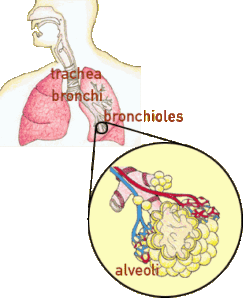What is Asthma
The word “Asthma” is derived from the Greek word AZ-MA meaning “to puff or pant”. Typical symptoms of asthma include wheezing, chest tightness, feeling short of breath and a persistent cough. These features often make breathing a struggle.
We breathe to live. The purpose of breathing is to supply the body with sufficient oxygen and to remove excess amounts of carbon dioxide.
To understand what happens during an asthma attack, you need to understand how the lungs work and what happens there.
The Lungs
The body’s breathing apparatus is known as the Respiratory Tree. The tree trunk (trachea) branches downward into a series of medium sized branches (bronchi) that separate into smaller branches (bronchioles). At the end of each bronchiole is a pouch of air sacs, known as alveoli, which resemble a bunch of grapes. It is within the alveoli that gas exchange takes place.

The lungs allow oxygen to enter the blood. When we breathe, the lungs deliver air to the alveoli. Tiny blood vessels flowing by the alveoli pick up oxygen and carry it throughout the body, nourishing the cells and tissue.
Simultaneously excess carbon dioxide passes from the tissue cells into the blood vessels. It passes into the alveoli and it is breathed out.
So What Goes Wrong?
Asthma attacks develop from an involuntary response to a trigger, such as:
Allergic reactions to substances like dust or pollen (an allergen)
Environmental factors like cold air
Illness
Physical activity or exercise.
Asthma causes an inflammatory response in the lungs. Airway linings swell up, the smooth muscle surrounding them contracts and excess mucus is produced. Airflow is now restricted, making it difficult for oxygen to get through to the alveoli and into the bloodstream.
All asthmatics share the problem of breathing difficulties. The way in which these difficulties present varies. Symptoms may include one, all or a combination the following: breathlessness, difficulty in exhaling, wheezing, “tight” or “heavy” chest, persistent cough, excessive amount of phlegm, a chronically blocked or running nose, extreme tiredness.
What determines the severity of an asthma attack?
The severity of an attack is determined by how restricted the airways become. When an asthmatic’s airways become chronically inflamed then only a slight trigger can cause a major reaction in the airways. When the inflammation is reduced, you might need to be exposed to two or three triggers before a restriction is noticed.
As a general rule, the longer an attack persists then the more dangerous it becomes. Oxygen levels can become low and even life-threatening.
